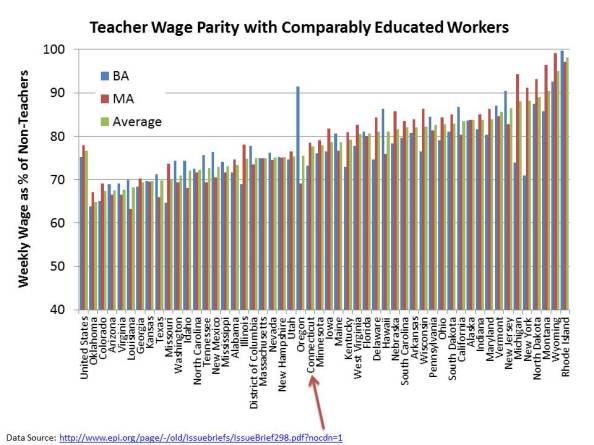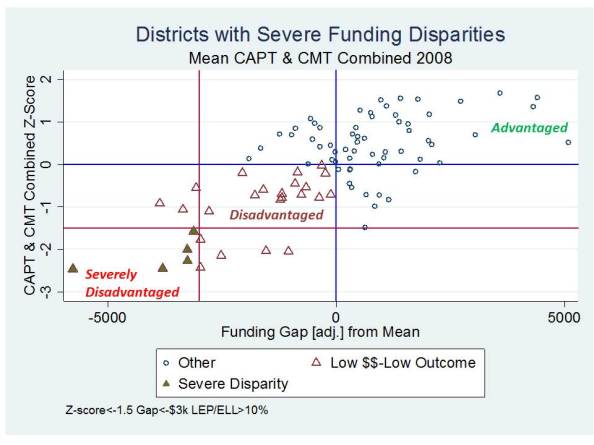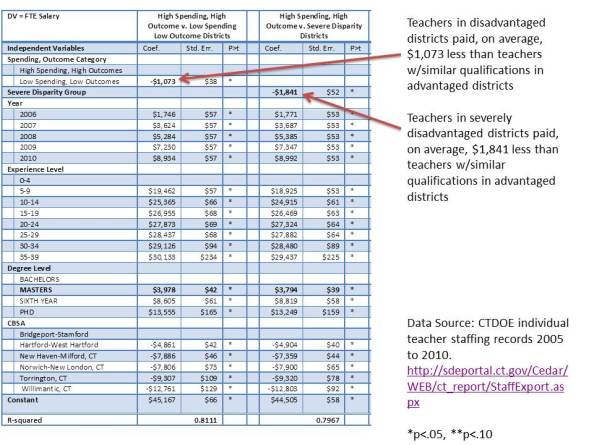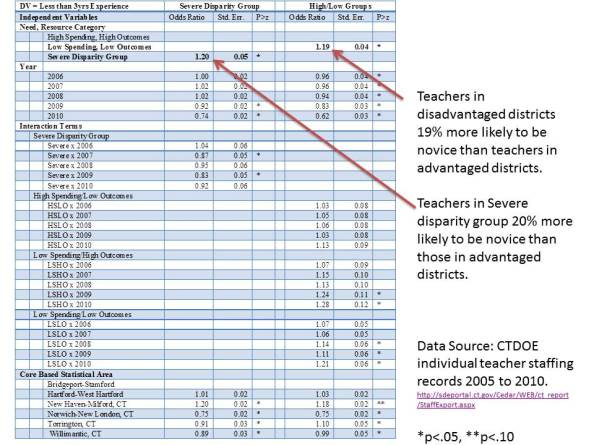SB24 Won’t Solve CT’s Real Teacher Equity Problems
Connecticut’s SB 24 appears to be little more than boilerplate reformy legislation which, like similar legislation in other states, creates a massive smokescreen concealing the very real problems facing Connecticut school districts. I addressed in a previous post my concern that SB24′s emphasis on charter expansion as a solution for high poverty districts is misguided, mainly because most of those successful charter schools in CT are currently achieving their successes at least in part by NOT serving high poverty populations. And another part may be the additional resources of these schools, used for such things as increased school time, supported by increased teacher salaries. But SB24 comes with few resources attached. The other major elements of SB24 involve teacher “effectiveness” with significant emphasis on use of student performance measures for teacher evaluation. For numerous posts on this topic, see: http://schoolfinance101.wordpress.com/category/race-to-the-top/value-added-teacher-evaluation/
A few points are in order before I move on.
First, even if we make value added measures about 20% of an evaluation system, and observations and other measures cover the rest, if the value-added measures vary most (which they are likely to, simply because they will be reported as statistically norm-referenced), then the value added measures likely become the tipping point more often than not. This is hugely problematic, given our inability to fully remove bias from these measures, and the fact that they remain so damn noisy as to hardly be useful at all(and are easily manipulated to yield different results for individual teachers)
Second, arguing that somehow using these noisy, potentially biased measures for personnel management or even mass deselection of teachers will somehow improve the equity of the distribution of teachers across advantaged and disadvantaged schools is simply absurd! This is especially the case if absolutely no attention is paid to existing underlying disparities in working conditions and teacher compensation.
The Real Connecticut Problem(s)
So, let’s take a look at what’s really going on in Connecticut regarding the distribution and compensation of teachers. But, let me begin with a bit of background literature on the relationship between funding and teacher quality. Rather than reinvent the wheel here, allow me to rely on a section of a policy brief I wrote last fall for Shanker Institute:
The Coleman report looked at a variety of specific schooling resource measures, most notably teacher characteristics, finding positive relationships between these traits and student outcomes. A multitude of studies on the relationship between teacher characteristics and student outcomes have followed, producing mixed messages as to which matter most and by how much.[i] Inconsistent findings on the relationship between teacher “effectiveness” and how teachers get paid – by experience and education – added fuel to “money doesn’t matter” fire. Since a large proportion of school spending necessarily goes to teacher compensation, and (according to this argument) since we’re not paying teachers in a manner that reflects or incentivizes their productivity, then spending more money won’t help.[ii] In other words, the assertion is that money spent on the current system doesn’t matter, but it could if the system was to change.
Of course, in a sense, this is an argument that money does matter. But it also misses the important point about the role of experience and education in determining teachers’ salaries, and what that means for student outcomes.
While teacher salary schedules may determine pay differentials across teachers withindistricts, the simple fact is that where one teaches is also very important in determining how much he or she makes.[iii] Arguing over attributes that drive the raises in salary schedules also ignores the bigger question of whether paying teachers more in general might improve the quality of the workforce and, ultimately, student outcomes. Teacher pay is increasingly uncompetitive with that offered by other professions, and the “penalty” teachers pay increases the longer they stay on the job.[iv]
A substantial body of literature has accumulated to validate the conclusion that both teachers’ overall wages and relative wages affect the quality of those who choose to enter the teaching profession, and whether they stay once they get in. For example, Murnane and Olson (1989) found that salaries affect the decision to enter teaching and the duration of the teaching career,[v] while Figlio (1997, 2002) and Ferguson (1991) concluded that higher salaries are associated with more qualified teachers.[vi] In addition, more recent studies have tackled the specific issues of relative pay noted above. Loeb and Page showed that:
“Once we adjust for labor market factors, we estimate that raising teacher wages by 10 percent reduces high school dropout rates by 3 percent to 4 percent. Our findings suggest that previous studies have failed to produce robust estimates because they lack adequate controls for non-wage aspects of teaching and market differences in alternative occupational opportunities.”[vii]
In short, while salaries are not the only factor involved, they do affect the quality of the teaching workforce, which in turn affects student outcomes.
Research on the flip side of this issue – evaluating spending constraints or reductions – reveals the potential harm to teaching quality that flows from leveling down or reducing spending. For example, David Figlio and Kim Rueben (2001) note that, “Using data from the National Center for Education Statistics we find that tax limits systematically reduce the average quality of education majors, as well as new public school teachers in states that have passed these limits.”[viii]
Salaries also play a potentially important role in improving the equity of student outcomes. While several studies show that higher salaries relative to labor market norms can draw higher quality candidates into teaching, the evidence also indicates that relative teacher salaries across schools and districts may influence the distribution of teaching quality. For example, Ondrich, Pas and Yinger (2008) “find that teachers in districts with higher salaries relative to non-teaching salaries in the same county are less likely to leave teaching and that a teacher is less likely to change districts when he or she teaches in a district near the top of the teacher salary distribution in that county.”[ix]
With regard to teacher quality and school racial composition, Hanushek, Kain, and Rivkin (2004) note: “A school with 10 percent more black students would require about 10 percent higher salaries in order to neutralize the increased probability of leaving.”[x]Others, however, point to the limited capacity of salary differentials to counteract attrition by compensating for working conditions.[xi]
Finally, it bears noting that those who criticize the use of experience and education in determining teachers’ salaries must of course produce a better alternative, and there is even less evidence behind increasingly popular ways to do so than there is to support the policies they intend to replace. In a perfect world, we could tie teacher pay directly to productivity, but contemporary efforts to do so, including performance bonuses based on student test results,[xii] have thus far failed to produce concrete results in the U.S. More promising efforts to measure productivity, such as new teacher evaluations that incorporate heavily-weighted teacher productivity measures based on their students’ test scores, are still a work in progress, and there is not yet evidence that they will be any more effective (or cost-effective) in attracting, developing or retaining high-quality teachers.
To summarize, despite all the uproar about paying teachers based on experience and education, and its misinterpretations in the context of the “Does money matter?” debate, this line of argument misses the point. To whatever degree teacher pay matters in attracting good people into the profession and keeping them around, it’s less about howthey are paid than how much. Furthermore, the average salaries of the teaching profession, with respect to other labor market opportunities, can substantively affect the quality of entrants to the teaching profession, applicants to preparation programs, and student outcomes. Diminishing resources for schools can constrain salaries and reduce the quality of the labor supply. Further, salary differentials between schools and districts might help to recruit or retain teachers in high need settings. In other words, resources used for teacher quality matter.
So then, how does this all play out in Connecticut? By the reformy rhetoric being so casually tossed about one would think that all of those urban CT teachers must already be being paid lavishly and certainly more than enough than would be required to get the best and brightest CT college grads to want to teach in Bridgeport or New Britain.
Let’s start with wages relative to non-teaching professions. Allegretto, Corcoran and Mishel identify Connecticut as having a relatively average teaching penalty.
In Connecticut, the average weekly wages of teachers are about 77.6% of the average weekly wages of similarly educated non-teachers.
But, we also know that Connecticut’s good schools and districts are pretty darn good. So perhaps the issue isn’t so much about the average, but about the disparities. Besides, the core rhetoric around the proposed reforms seems to be much about the achievement gap in CT, which is indeed large even when corrected for the income gap.
Let’s quickly revisit my representation of which districts in CT are most disadvantaged, when we look at the relationship between cost and need adjusted per pupil expenditures and average current outcomes:
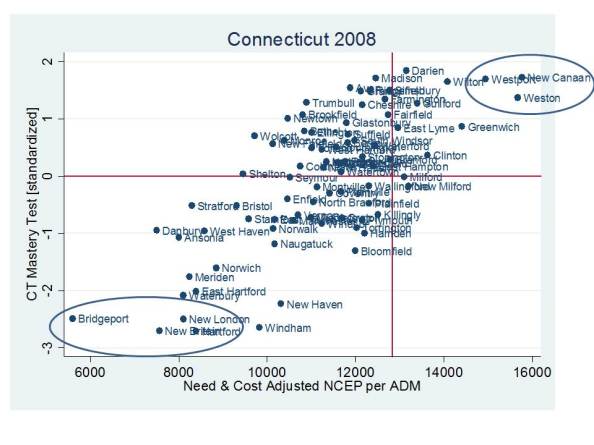 Expressing the funding as difference from the average, and throwing some cutpoints into the picture to create some fun groups for comparison, I get:
Expressing the funding as difference from the average, and throwing some cutpoints into the picture to create some fun groups for comparison, I get:
So, I’ve got the advantaged districts which have high adjusted spending and high outcomes. I’ve got my overall group of disadvantaged districts which have low adjusted spending and low outcomes, and a particularly screwed subset of these districts which I call severely disadvantaged (including Bridgeport and New Britain).
Now, recall, that the funding side of the Malloy plan isn’t going to do a whole lot to help out these districts.
Notice that huge infusion of funding represented by the red triangles relative to prior year Net Current Expenditures. Oh wait. There really isn’t any. But what’s funding got to do with it anyway? (go back and read the above section!)
So, I’ve taken the teacher level salary and characteristics data to estimate two different models of the differences in teacher characteristics between the advantaged and disadvantaged districts and between the advantaged and severely disadvantaged districts. First, let’s look simply at salary parity at constant teacher characteristics. NOTE THAT IT WOULD TAKE NOT ONLY AN EQUAL, BUT HIGHER SALARY, FOR EXAMPLE, TO GET TEACHERS WITH SPECIFIC QUALIFICATIONS TO WORK IN BRIDGEPORT AS OPPOSED TO WESTPORT.
Here’s the salary model, with comments in the margins:
All else equal, teachers in disadvantaged districts are still behind their peers in advantaged districts within the same labor market. Reformy platitudes and test based evaluation will not fix that!
Now, here’s a logistic regression of the likelihood that a teacher is a novice, or in his/her first 3 years of teaching. This is a commonly used marker for teacher quality inequity, because a substantial body of literature has found that concentrations of novice teachers (i.e. teachers with less than 3 or 4 years of experience) can have significant negative effects on student outcomes.[1] Rivkin, Hanushek, and Kain (2005) find that teacher experience is important in the first two years of a teaching career (but not thereafter).[2] Hanushek and Rivkin note that: “we find that identifiable school factors – the rate of student turnover, the proportion of teachers with little or no experience, and student racial composition – explain much of the growth in the achievement gap between grades 3 and 8 in Texas schools.”[3] Notably, evidence from a variety of state and local contexts, provides a consistent picture that higher concentrations of novice teachers are associated with negative effects on student outcomes.
Here are the models:
So, kids in classrooms in severely disadvantaged or generally disadvantaged districts are each about 20% more likely to face novice teachers. Note that they are also more likely to be in larger classes, specifically if they are in the severe disparity group!
Again, SB24′s reformy platitudes will do nothing to remedy this disparity.
Put simply, the SB24 teacher effectiveness provisions are a massive smokescreen that do little or nothing to address persistent underlying disparities across CT districts. Worse, the misguided emphasis on reducing job security and focusing on problematic performance metrics will likely do more harm than good for children in the most disadvantaged districts.
[i] Hanushek, E.A. (1971) Teacher Characteristics and Gains in Student Achievement: Estimation Using MicroData. Econometrica 61 (2) 280-288
Clotfelter, C.T., Ladd, H.F., Vigdor, J.L. (2007) Teacher credentials and student achievement: Longitudinal analysis with student fixed effects. Economics of Education Review 26 (2007) 673–682
Goldhaber, D., Brewer, D. (1997) Why Don’t Schools and Teachers Seem to Matter? Assessing the Impact of Unobservables on Educational Productivity. The Journal of Human Resources, 332 (3) 505-523
Ehrenberg, R. G., & Brewer, D. J. (1994). Do school and teacher characteristics matter? Evidence from High School and Beyond. Economics of Education Review, 13(1), 1-17.
Ehrenberg, R. G., & Brewer, D. J. (1995). Did teachers’ verbal ability and race matter in the 1960s?Economics of Education Review, 14(1), 1-21.
Jepsen, C. (2005). Teacher characteristics and student achievement: Evidence from teacher surveys.Journal of Urban Economics, 57(2), 302-319.
Jacob, B. A., & Lefgren, L. (2004). The impact of teacher training on student achievement: Quasi-experimental evidence from school reform. Journal of Human Resources, 39(1),50-79.
Rivkin, S. G., Hanushek, E. A., & Kain, J. F. (2005). Teachers, schools, and academic achievement.Econometrica, 73(2), 471.
Wayne, A. J., & Youngs, P. (2003). Teacher characteristics and student achievement gains. Review of Educational Research, 73(1), 89-122.
For a recent review of studies on the returns to teacher experience, see:
Rice, J.K. (2010) The Impact of Teacher Experience: Examining the Evidence and Policy Implications. National Center for Analysis of Longitudinal Data in Educational Research.
[ii] Some go so far as to argue that half or more of teacher pay is allocated to “non-productive” teacher attributes, and so it follows that that entire amount of funding could be reallocated toward making schools more productive.
See, for example, a recent presentation to the NY State Board of Regents from September 13, 2011 (page 32), slides by Stephen Frank of Education Resource Strategies:http://www.p12.nysed.gov/mgtserv/docs/SchoolFinanceForHighAchievement.pdf
[iii] Lankford, H., Loeb., S., Wyckoff, J. (2002) Teacher Sorting and the Plight of Urban Schools. Educational Evaluation and Policy Analysis 24 (1) 37-62
[iv] Allegretto, S.A., Corcoran, S.P., Mishel, L.R. (2008) The teaching penalty : teacher pay losing ground. Washington, D.C. : Economic Policy Institute, ©2008.
[v] Richard J. Murnane and Randall Olsen (1989) The effects of salaries and opportunity costs on length of state in teaching. Evidence from Michigan. Review of Economics and Statistics 71 (2) 347-352
[vi] David N. Figlio (2002) Can Public Schools Buy Better-Qualified Teachers?” Industrial and Labor Relations Review 55, 686-699. David N. Figlio (1997) Teacher Salaries and Teacher Quality. Economics Letters 55 267-271. Ronald Ferguson (1991) Paying for Public Education: New Evidence on How and Why Money Matters. Harvard Journal on Legislation. 28 (2) 465-498.
[vii] Loeb, S., Page, M. (2000) Examining the Link Between Teacher Wages and Student Outcomes: The Importance of Alternative Labor Market Opportunities and Non-Pecuniary Variation. Review of Economics and Statistics 82 (3) 393-408
[viii] Figlio, D.N., Rueben, K. (2001) Tax Limits and the Qualifications of New Teachers. Journal of Public Economics. April, 49-71
See also:
Downes, T. A. Figlio, D. N. (1999) Do Tax and Expenditure Limits Provide a Free Lunch? Evidence on the Link Between Limits and Public Sector Service Quality52 (1) 113-128
[ix] Ondrich, J., Pas, E., Yinger, J. (2008) The Determinants of Teacher Attrition in Upstate New York. Public Finance Review 36 (1) 112-144
[x] Hanushek, Kain, Rivkin, “Why Public Schools Lose Teachers,” Journal of Human Resources 39 (2) p. 350
[xi] Clotfelter, C., Ladd, H.F., Vigdor, J. (2011) Teacher Mobility, School Segregation and Pay Based Policies to Level the Playing Field. Education Finance and Policy , Vol.6, No.3, Pages 399–438
Clotfelter, Charles T., Elizabeth Glennie, Helen F. Ladd, and Jacob L. Vigdor. 2008. Would higher salaries keep teachers in high-poverty schools? Evidence from a policy intervention in North Carolina.Journal of Public Economics 92: 1352–70.
[xii] For recent studies specifically on the topic of “merit pay,” each of which generally finds no positive effects of merit pay on student outcomes, see:
Glazerman, S., Seifullah, A. (2010) An Evaluation of the Teacher Advancement Program in Chicago: Year Two Impact Report. Mathematica Policy Research Institute. 6319-520
Springer, M.G., Ballou, D., Hamilton, L., Le, V., Lockwood, J.R., McCaffrey, D., Pepper, M., and Stecher, B. (2010). Teacher Pay for Performance: Experimental Evidence from the Project on Incentives in Teaching. Nashville, TN: National Center on Performance Incentives at Vanderbilt University.
Marsh, J. A., Springer, M. G., McCaffrey, D. F., Yuan, K., Epstein, S., Koppich, J., Kalra, N., DiMartino, C., & Peng, A. (2011). A Big Apple for Educators: New York City’s Experiment with Schoolwide Performance Bonuses. Final Evaluation Report. RAND Corporation & Vanderbilt University.
[1] See Charles T. Clotfelter, Helen F. Ladd and Jacob L. Vigdor, “Who Teaches Whom? Race and the distribution of novice teachers,” Economics of Education Review 24, no. 4 (August, 2005): 377-392; See Charles T. Clotfelter, Helen F. Ladd and Jacob L. Vigdor, “Teacher sorting, teacher shopping, and the assessment of teacher effectiveness,” Sanford Institute of Public Policy, Duke University, 2004; and Hanushek, Kain, and Rivkin, “Teachers, schools, and academic achievement.”
[2] Hanushek, Kain, and Rivkin, “Teachers, schools, and academic achievement.”
This blog post has been shared by permission from the author.
Readers wishing to comment on the content are encouraged to do so via the link to the original post.
Find the original post here:
The views expressed by the blogger are not necessarily those of NEPC.
